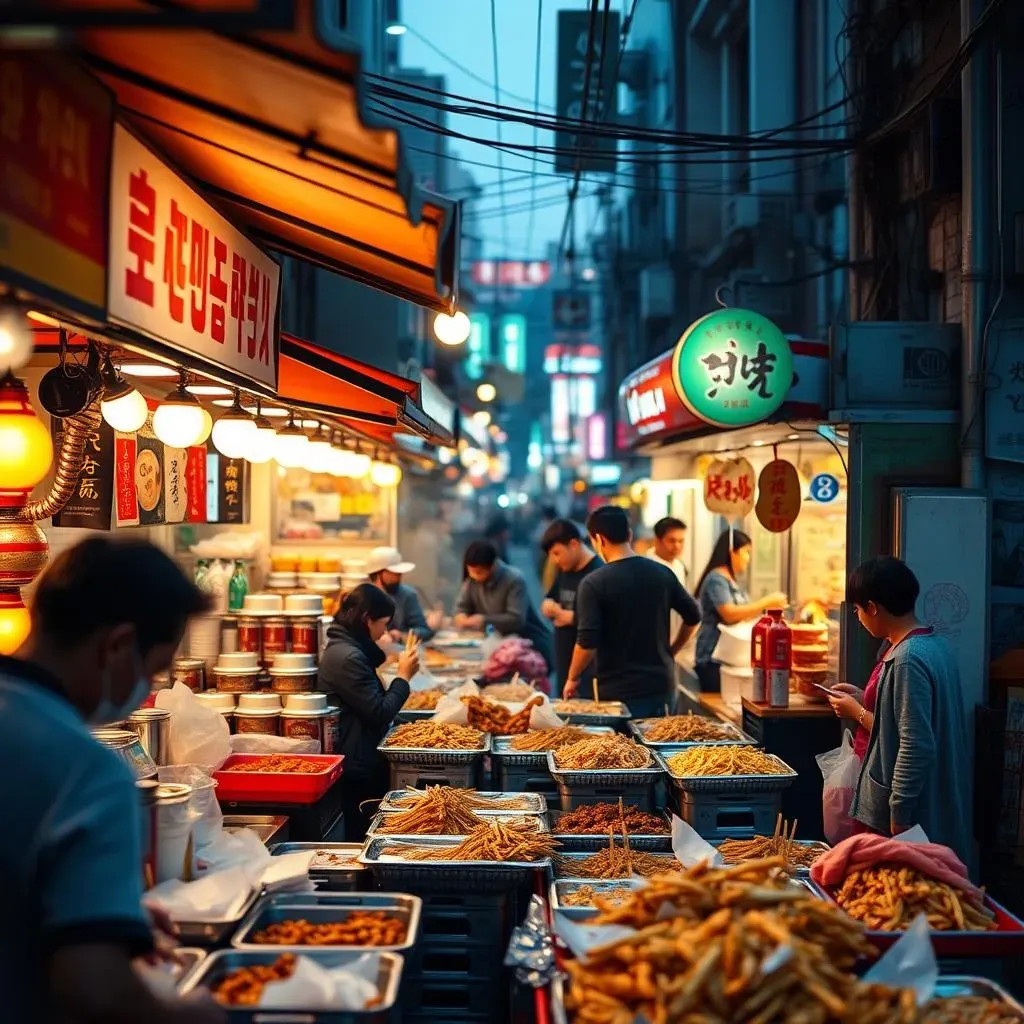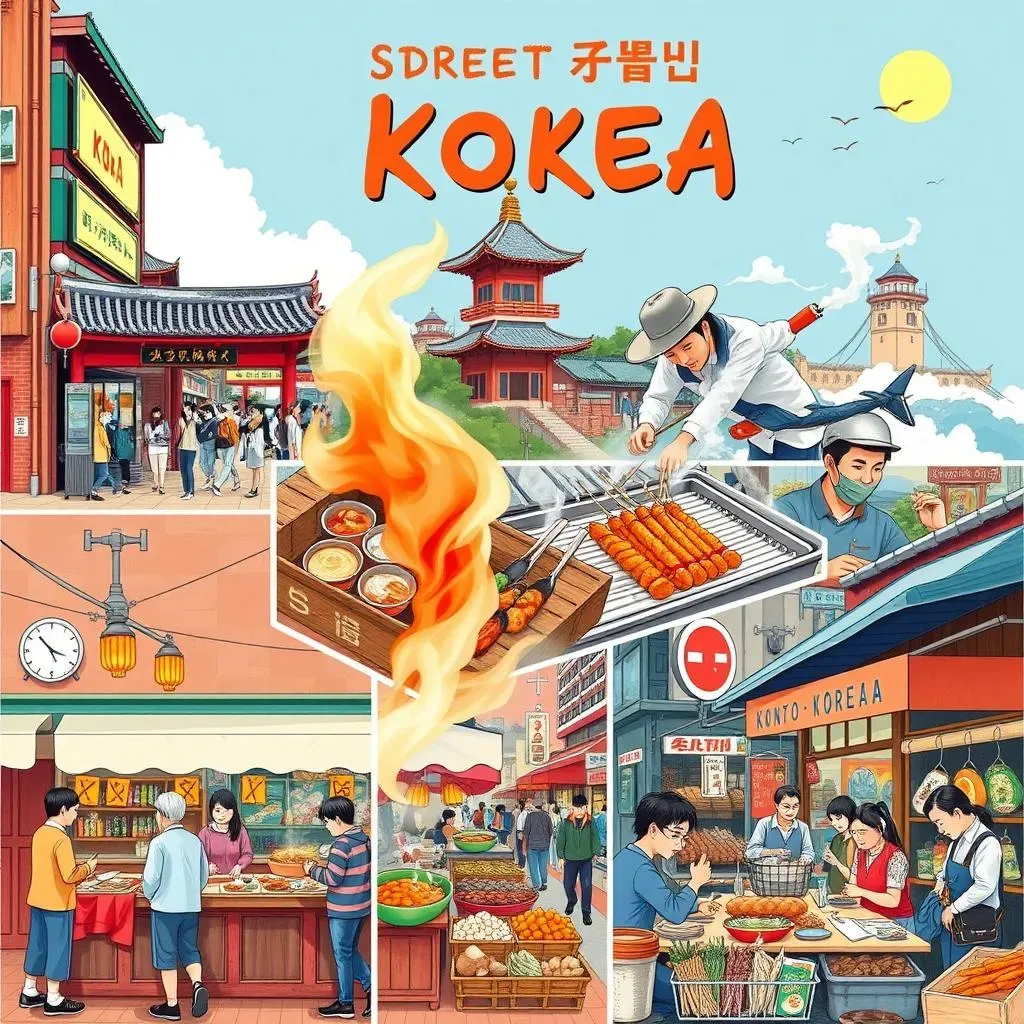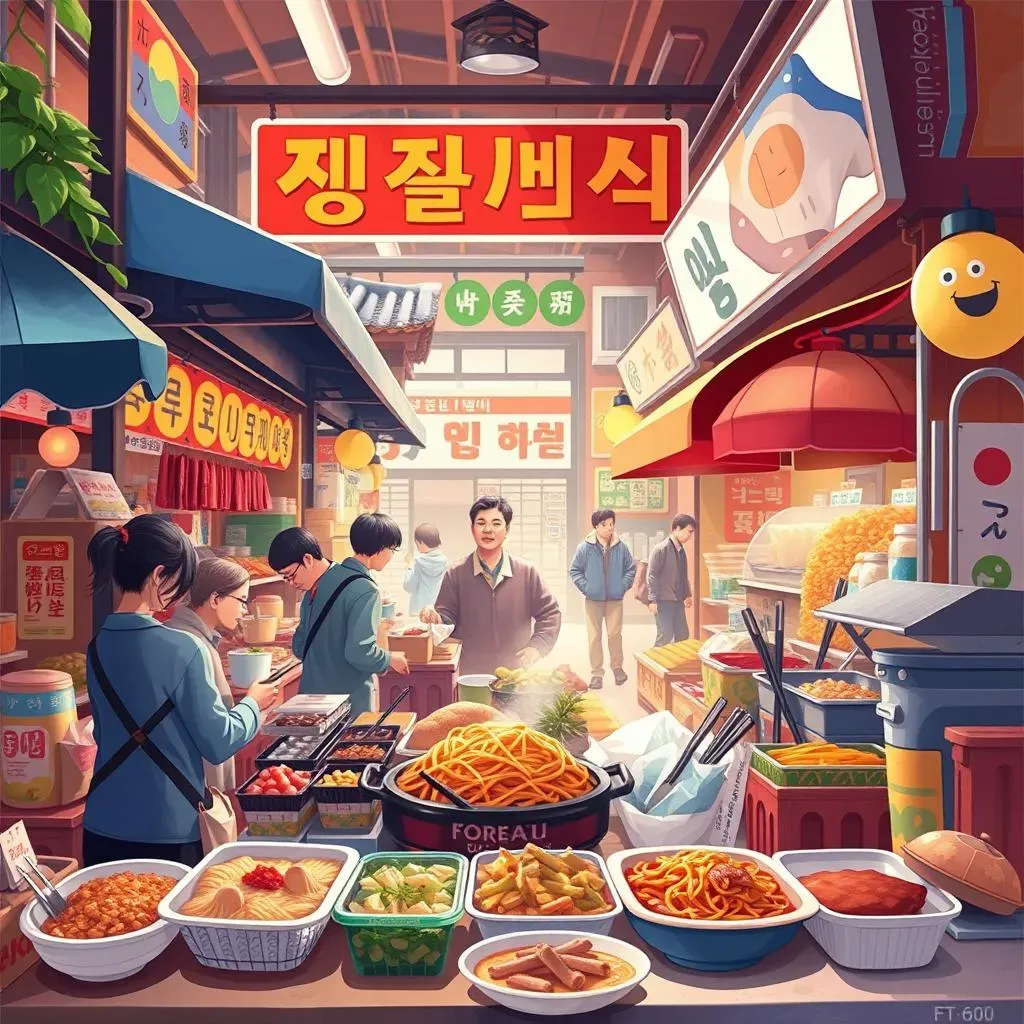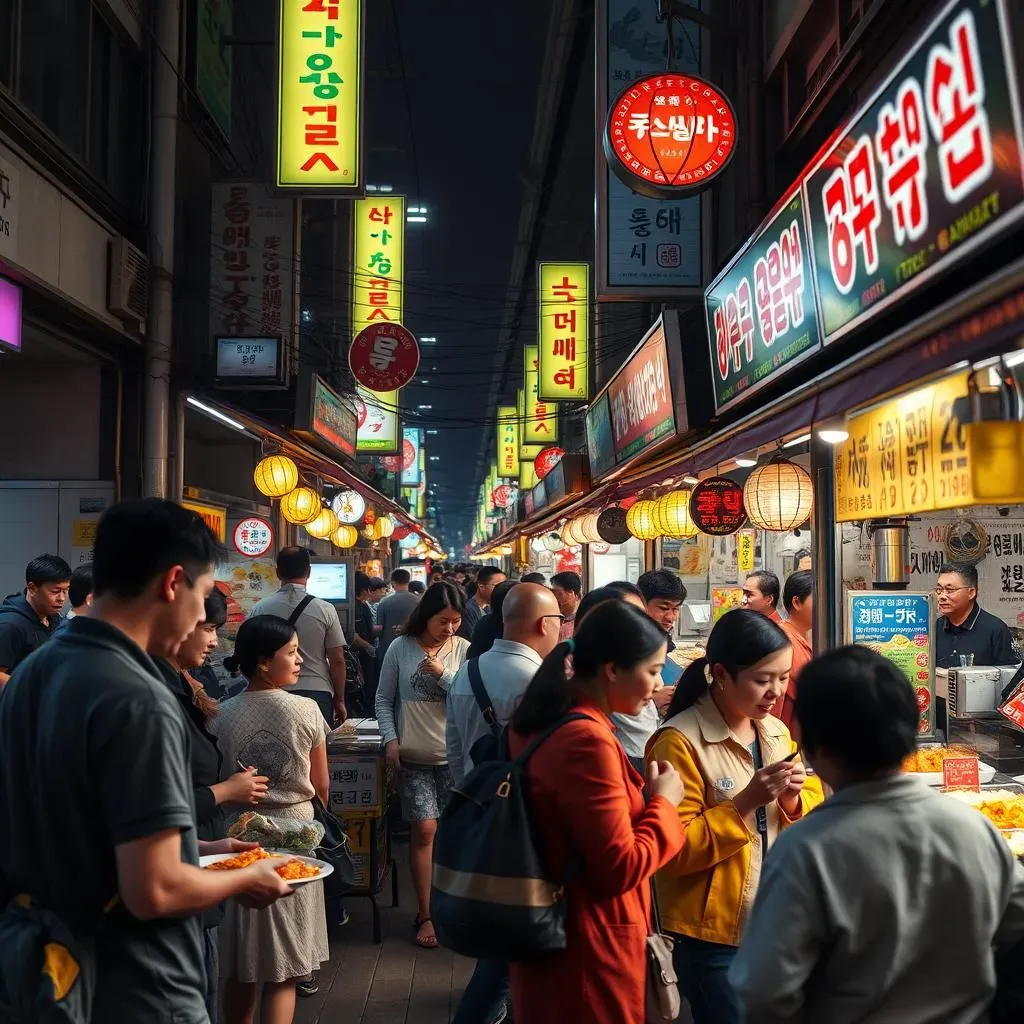Table of Contents
Get ready for a culinary adventure! This article is your passport to the exciting world of street food in Korean. We'll embark on a delicious journey, exploring the vibrant tapestry of flavors and textures that make Korean street food so unique. Prepare your taste buds for an explosion of sensations – from the spicy kick of tteokbokki to the savory delight of hotteok. We'll not only uncover the most popular dishes and snacks but also delve into the rich cultural context surrounding them. Discover the best places to find these treats, learn some helpful ordering phrases, and uncover hidden gems often missed by tourists. This guide isn't just about the food; it's about experiencing the heart and soul of Korean culture, one delicious bite at a time. So, whether you're a seasoned foodie or a curious traveler, prepare to be amazed by the incredible diversity and irresistible charm of street food in Korean. Let's begin!
The Best Street Food in Korean: A Foodie's Guide
The Best Street Food in Korean: A Foodie's Guide
Discovering the Delights of Korean Street Food
Hey there, fellow food enthusiast! So you're diving into the amazing world of Korean street food? Fantastic choice! You're in for a treat. Forget bland tourist traps; Korean street food is a vibrant, ever-evolving culinary landscape bursting with flavor and history. From the fiery spice of classic tteokbokki to the sweet, chewy goodness of hotteok, there's something to satisfy every craving. It's not just about the food itself, though; it's about the bustling atmosphere, the friendly vendors, and the unique cultural experience. Think of it as a delicious adventure waiting to be explored. We'll be covering everything from the most popular dishes to lesser-known regional specialties, giving you the inside scoop on where to find the best eats and how to navigate the street food scene like a pro. Ready to get started?
One of the best ways to start your Korean street food journey is to explore the diverse regional variations. For example, the spicy tteokbokki you find in Seoul might have a slightly different flavor profile than what you'd find in Busan. Each region boasts its own unique specialties and culinary traditions, reflecting the diverse history and culture of Korea. Want to know more about specific regional dishes? Check out our guide to Korean street food regions to discover the hidden gems waiting for you.
Region | Specialty Dish | Description |
|---|---|---|
Seoul | Tteokbokki | Spicy rice cakes in a savory sauce |
Busan | Ssiat Hotteok | Sweet pancakes with various fillings |
Jeju | Black Pork | Grilled black pork skewers |
Beyond the famous dishes, there's a whole world of lesser-known treats waiting to be discovered. Think about crispy fried squid, chewy fish cakes (eomuk), and the irresistible sweetness of roasted sweet potatoes. These are just a few examples of the amazing diversity you'll find. We'll be providing a comprehensive list of must-try dishes later in this article, but for now, let's talk about the best places to experience this culinary adventure.
Many cities in Korea offer incredible street food experiences, but some stand out more than others. Seoul, of course, is a must-visit, with its iconic Myeongdong shopping street bursting with food stalls. But don't overlook other cities like Busan, Gwangju, or Jeonju, each with its unique culinary offerings. For those seeking a more authentic experience, venture beyond the main tourist areas and explore local markets. You might be surprised at the hidden gems you uncover! For more information on where to find the best street food in Korea, check out our post on Korean street food markets.
- Myeongdong (Seoul)
- Gwangjang Market (Seoul)
- Bupyeong Kkangtong Market (Busan)
- Jeonju Hanok Village (Jeonju)
Exploring Diverse Korean Street Food Regions
Exploring Diverse Korean Street Food Regions
Seoul's Street Food Scene
Seoul, the buzzing capital, sets the stage for an incredible street food experience. Myeongdong, a shopper's paradise, is a prime example, overflowing with vendors selling everything from spicy tteokbokki to sweet hotteok. But don't limit yourself to the main streets; explore the hidden alleys and smaller markets for truly authentic finds. You'll discover unique flavors and regional variations you won't find anywhere else. The energy is infectious, and the sheer variety is mind-boggling. It's a feast for the senses, a symphony of sizzling sounds and tantalizing aromas. Want to learn more about the history of Korean street food? Check out our deep dive into Korean street food history.
Beyond Myeongdong, Seoul offers a treasure trove of street food havens. Gwangjang Market, a historic landmark, boasts a vast array of traditional dishes. From savory pancakes (bindaetteok) to comforting rice cakes, this market is a must-visit for any serious foodie. Similarly, Namdaemun Market, a sprawling marketplace, offers a unique blend of traditional and modern street food. Don't be afraid to wander and explore; you never know what culinary delights you might stumble upon. Looking for a guided tour? Check out our suggestions for Korean street food tours.
- Myeongdong: Bustling hub with diverse options.
- Gwangjang Market: Historic market with traditional fare.
- Namdaemun Market: Large marketplace with diverse offerings.
Coastal Delights: Busan's Street Food
Busan, South Korea's second-largest city, offers a completely different street food experience. Its coastal location heavily influences its cuisine, resulting in fresh seafood dishes and unique regional specialties. The vibrant Jagalchi Fish Market is a must-visit, where you can sample an array of freshly caught seafood prepared right before your eyes. From grilled fish skewers to sizzling seafood pancakes, the market is a sensory overload in the best possible way. Want to try some unique Korean street food desserts? Check out our article on Korean street food desserts.
Beyond the fish market, Busan's streets are lined with vendors offering a variety of tempting treats. Look out for ssiat hotteok, a type of pancake filled with sweet brown sugar and nuts. Busan's street food scene is a reflection of its lively and dynamic culture – a perfect blend of tradition and innovation. For a more detailed look at Busan's unique offerings, check out our guide to Busan street food (coming soon!).
Dish | Description | Where to Find It |
|---|---|---|
Ssiat Hotteok | Sweet pancake with various fillings | Throughout Busan |
Grilled Seafood | Freshly caught seafood grilled to perfection | Jagalchi Fish Market |
Beyond the Big Cities: Regional Specialties
While Seoul and Busan dominate the conversation, don't overlook the incredible street food scene in smaller cities and regions. Jeonju, famous for its bibimbap, also boasts a unique street food culture, often incorporating local ingredients and culinary traditions into its offerings. Gwangju, known for its vibrant culture, offers a similarly exciting culinary landscape, with dishes often reflecting the region's agricultural heritage. These regional variations are what truly makes Korean street food so special – a delicious mosaic reflecting the country's diverse landscape and history. For example, Jeju Island is known for its unique black pork, which is often grilled and served on skewers.
Exploring these lesser-known regions is a rewarding experience for any adventurous foodie. You'll not only discover new and exciting flavors but also gain a deeper appreciation for the cultural richness of Korea. Each region has its own unique story to tell, expressed through its culinary traditions. Take the time to explore, to ask questions, and to savor the unique flavors of each region. Want to learn more about the best street food stalls? Check out our guide on Korean street food stalls.
- Jeonju: Bibimbap-inspired street food.
- Gwangju: Dishes reflecting agricultural heritage.
- Jeju Island: Unique black pork skewers.
MustTry Korean Street Food Dishes and Snacks
MustTry Korean Street Food Dishes and Snacks
The Classics and Beyond
Alright, let's talk about the *real* stars of the show: the must-try Korean street food dishes and snacks! We've covered the regions, now let's dive into the delicious details. You absolutely *have* to try tteokbokki, those chewy rice cakes swimming in a spicy, sweet, and savory sauce. It's a Korean street food staple for a reason – seriously addictive! Then there's hotteok, the warm, gooey pancake filled with sweet brown sugar and cinnamon. It's the perfect sweet treat to balance out all that spice. But don't stop there! Explore the amazing variety of kkochi (skewers), from savory grilled meats to delightful seafood options. Think juicy chicken skewers, chewy fish cakes (eomuk), and even crispy squid.
Beyond the well-known dishes, you'll find a world of hidden gems waiting to be discovered. Have you ever tried gamja-hotdog (a corn dog wrapped in french fries)? Or maybe hwori gamja (tornado potatoes)? These innovative snacks show the creativity and fun that defines Korean street food. Don't forget about the simpler pleasures, like roasted sweet potatoes (gun goguma), a perfect warming treat for a chilly evening. And if you have a sweet tooth, you absolutely *must* sample the many Korean street food desserts available. For a deeper dive into the sugary side of things, check out our guide to Korean street food desserts.
Dish | Description | Spice Level |
|---|---|---|
Tteokbokki | Chewy rice cakes in spicy sauce | High |
Hotteok | Sweet pancake with brown sugar & cinnamon | None |
Eomuk | Fish cake skewers | Mild |
Beyond the Basics: Regional Variations and Hidden Gems
Remember those regional variations we talked about? Well, they extend to individual dishes too! The same dish can taste wildly different depending on where you are in Korea. A tteokbokki in Seoul might be spicier than one in Busan, for instance. Keep an open mind and try different versions of the same dish—you might find your new favorite! And don't be afraid to venture beyond the most popular options; the truly unique experiences often lie in the lesser-known snacks.
Think about exploring unique regional snacks that aren't as widely known. For example, Jeju Island, famous for its volcanic landscape, offers unique dishes featuring local ingredients. Similarly, smaller cities and towns often have their own hidden culinary gems, reflecting local traditions and ingredients. These are the dishes that will truly make your Korean street food journey unforgettable. To learn more about finding authentic dishes, check out our article on authentic Korean street food.
- Bindae-tteok (mung bean pancakes): Savory and delicious.
- Gyeran-ppang (egg bread): Sweet and savory combination.
- Bungeoppang (fish-shaped pastries): Filled with sweet red bean paste.
Korean Street Food Etiquette and Cultural Insights
Korean Street Food Etiquette and Cultural Insights
Navigating Korean Street Food Culture
So you're ready to dive into the delicious world of Korean street food? Awesome! But before you grab that first tteokbokki, let's talk etiquette. While Koreans are generally welcoming to tourists, understanding a few cultural nuances can enhance your experience and show respect for local customs. First off, cash is king! Many street vendors primarily accept cash, so it's wise to have some on hand. Don't worry about precise change; rounding up is common and perfectly acceptable. Next, observe the flow of the crowd. Street food stalls are often located in busy areas, so be mindful of others as you navigate the bustling scene. Finding a spot to eat your delicious treats might involve some creative maneuvering!
When ordering, a simple "Annyeonghaseyo" (hello) goes a long way. Pointing at what you want is perfectly fine, especially if you don't speak Korean. Most vendors are used to tourists and happy to help. Once you've received your food, find a spot to enjoy it. Many street food areas have designated eating areas, but sometimes you'll be eating on the go. Remember to dispose of your trash properly – there are usually trash cans nearby. For more tips on how to navigate the street food scene, check out our post on Korean street food etiquette (coming soon!).
- Carry cash for most transactions.
- Be mindful of others in busy areas.
- Use polite greetings when ordering.
- Dispose of your trash responsibly.
Sharing the Experience
Korean street food is often a social affair. Sharing dishes with friends or family is common, adding to the overall enjoyment. Don't be afraid to try a variety of dishes and share them with your companions. It's a great way to discover new flavors and create lasting memories. Sharing food is a way to connect with others and build camaraderie, so embrace the opportunity!
Beyond the food itself, pay attention to the atmosphere. Observe how locals interact with vendors, and try to soak up the energy of the street food scene. This is a chance to experience a different side of Korean culture, beyond the typical tourist attractions. The bustling energy, the friendly interactions, and the shared experience of enjoying delicious food all contribute to the magic of Korean street food. For a more in-depth look at Korean food culture, check out our article on Korean food culture (coming soon!).
Aspect | Tip |
|---|---|
Ordering | Pointing is acceptable, but a polite greeting is appreciated. |
Payment | Cash is preferred; rounding up is common. |
Eating | Sharing food is encouraged; dispose of trash properly. |